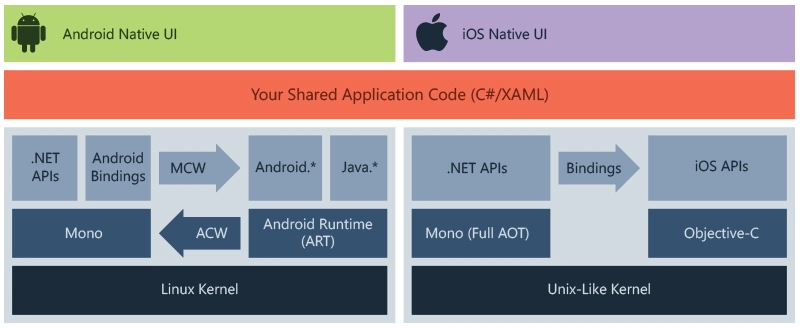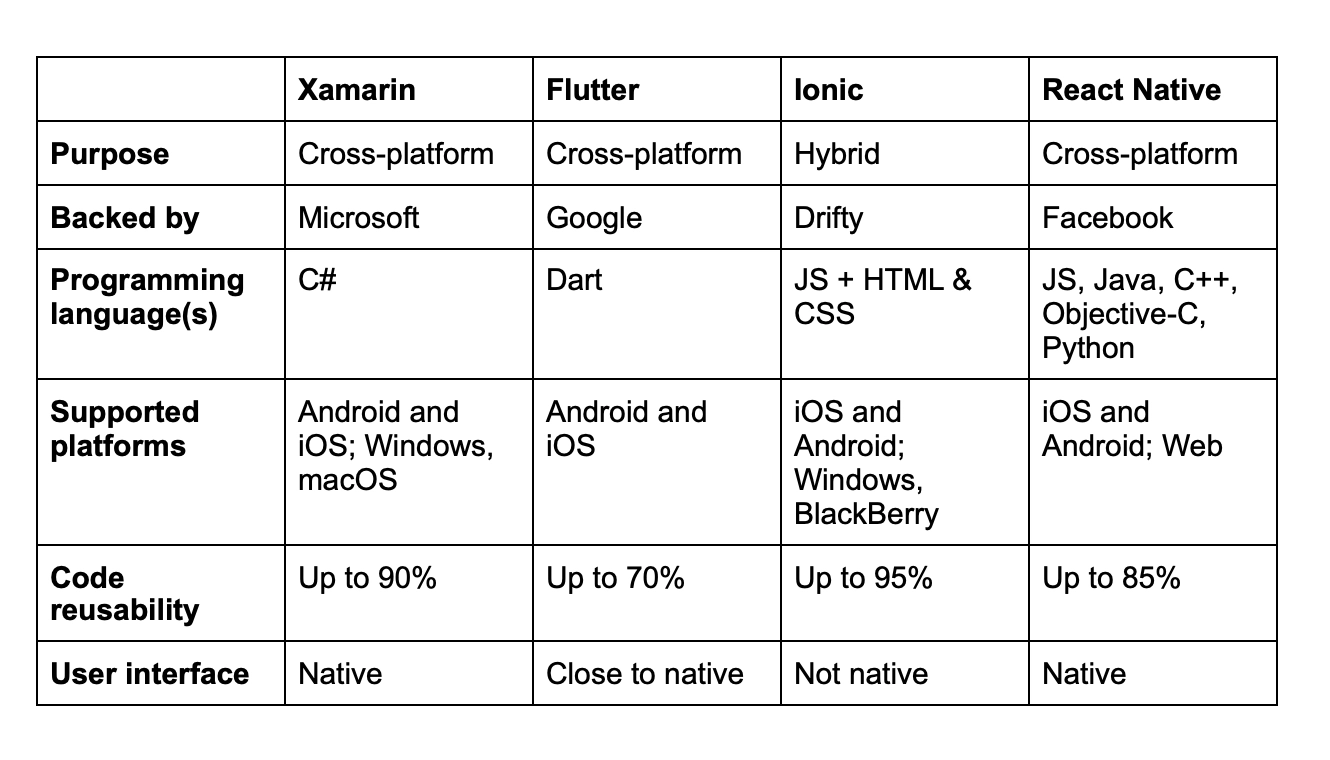Blog
Xamarin simplifies cross-platform app development, all the while cutting high costs, accelerating time to market, and simplifying maintenance. In this blog, we discuss all strengths (code reusability, native UX) and weaknesses (licensing fees, larger app size), helping decision-makers evaluate its fit for their next mobile project.
Most businesses want to have mobile applications for both iOS and Android devices.
However, the amount of time and money required for building native apps often becomes a
major constraint. Fortunately, there is always an option of cross-platform development
that is a more affordable but still reliable alternative. Nowadays, a list of technologies
allowing programmers to create mobile apps for different platforms in one shot is quite
long. But Xamarin holds a leadership position, being recognized by many developers and
business owners all over the globe.
This article will outline the main Xamarin pros and cons as compared to other multi-platform
tools. But, first, let’s briefly review some basics.
What is Xamarin?
Xamarin is a platform for developing Android, iOS, and Windows mobile applications in a
single language. It was created by Miguel de Icaza, a Mexican-American software engineer,
who sold the company to Microsoft in 2016. Today, Xamarin is considered a fully Microsoft
project. The latter provides continuous support to this technology and invests in its
popularization.
Besides an open-source cross-platform development framework, Xamarin has a number of side products.
For example, they include:
- Xamarin.Forms for designing and building native mobile app interfaces from a single API
- Xamarin Test Cloud for acceptance testing mobile applications
- Xamarin for Visual Studio that is a development environment (i.e., the extension for Microsoft Visual Studio)
- Xamarin Studio that is a standalone development environment
- .NET Mobility Scanner for checking how much of the code can be shared with other platforms
Statistics show that the number of Xamarin developers has already exceeded 1.4 million . Since the platform is still rather young, this figure seems quite promising.
How Xamarin works
Xamarin development allows programmers to share code when building applications for different platforms. It means that they can create iOS, Android, and even web apps without the necessity to write separate code for each of these products from scratch. But while the business logic is the same, the Xamarin platform lets you achieve a native look and performance of applications on all targeted operating systems.

The core logic of all Xamarin-based apps is written with the help of the C# programming
language. So, iOS, Android, and Windows applications share most of the codebase, along
with APIs and data structures. At the same time, the C# codebase has to be ‘converted’ to
get access to platform-specific feature-sets available for native SDK. It becomes possible
with Xamarin tools (e.g., Xamarin.iOS and Xamarin.Android) that allow programmers to
compile the C# code.
In addition, the Xamarin platform lets you create a native app layer and user interface. As
a result, apps for different platforms feel and behave like native products, even though they
are built with a single codebase and IDE.
Pros of using Xamarin for development
Why do businesses choose Xamarin? This technology offers a lot of unique benefits that optimize a mobile development process and ensure positive project outcomes in the end. Here are the main advantages of Xamarin:
Write once, use everywhere
The possibility to write a single code for all solutions is the most obvious Xamarin benefit, but it’s also the most essential one. The exact amount of code that can be shared among different platforms mostly depends on the way the code is distributed between the core and user interface. But, in general, the Xamarin technology allows a development team to create about 65-90 percent of reusable code. This advantage significantly simplifies and speeds up the development process. For clients, it saves money and accelerates time to market.
Near-native performance
Enabling the app’s performance that is close to native is also one of the most important Xamarin pros. Some other multi-platform tools use another pattern for mobile app development. In particular, they allow for building mobile applications like websites, i.e., using such technologies as HTML, CSS, and JavaScript. Basically, such apps run inside a browser, but web pages are displayed as a native application. This usually results in poor performance and user experience With Xamarin, programmers can achieve performance metrics that are practically indistinguishable from native apps. It makes Xamarin stand out from other cross-platform mobile development platforms.
Native user experience
Ensuring an outstanding user experience is one of the top reasons why businesses opt for custom mobile development. However, Xamarin provides programmers with all the tools they need to create the native UX for cross-platform applications. How is it possible? Xamarin.Forms allows for sharing UI components across different platforms by showing them as platform-specific interface elements at runtime. Developers can also use Xamarin.iOS and Xamarin.Android to create a native app UI and get even better results.
Strong Microsoft support
As mentioned, Xamarin is backed by the Microsoft corporation, and it’s a huge advantage for enterprises looking for reliable technology. First of all, it means that this mobile development platform will be timely updated and won’t retire in the foreseeable future. Secondly, Xamarin provides the community with a variety of learning resources. Microsoft considers this technology as its strategic product and offers wide learning opportunities for software engineers who want to start working with Xamarin.
Simplified code maintenance
The maintenance of Xamarin apps is usually easier than the maintenance of native products. To update apps developed for different platforms, programmers just need to make changes to the source file. Such changes are automatically reflected in iOS, Android, and other products (if any). Another aspect is the convenience of cooperation with developers. When a product is based on Xamarin, one person can cover the entire scope of work and keep an app updated. Since there is no need to duplicate changes on each platform, you can save a lot of time and money.
Full hardware support
Since using Xamarin enables building native-level functionality in cross-platform apps, the risk of hardware compatibility issues is practically eliminated. By using different APIs and platforms, programmers can create products that run smoothly on all targeted devices. In addition, Xamarin allows for an advanced level of customization by enabling the connection with native libraries.
Xamarin cons to consider
Like any other technology, Xamarin has some drawbacks as well. Let’s take a look at the most crucial of them that may impact your decision-making.
Pricing
Xamarin itself is open-source. But for commercial development, you’ll also need Visual Studio that may cost a lot. The pricing starts at $1,199 for the first subscription year for the professional package. The subsequent renewals are cheaper, but they are still not free and would cost you $799 per year. If you need an enterprise package, the prices will range from $2,569 to $5,999. But this pricing can be a problem only if you plan the in-house development. Most outsourcing companies already have all the required licenses, and their price can hardly impact the costs of separate projects.
Xamarin community
The Xamarin community is continuously growing but it is still considerably smaller than, for example, the iOS or Android communities. It means that you can face a problem if you need to find a professional Xamarin developer quickly. Many people consider it the most significant disadvantage of Xamarin. However, if you cooperate with a development company rather than individual engineers, the burden of finding experienced programmers will lie on its shoulders. Also, the Xamarin learning curve is minimal for C# developers. So the lack of an available talent pool should not be a reason not to use this technology.
Larger size of apps
Xamarin-based applications are usually slightly heavier than their native analogous products. The reason is code overhead that appears due to the necessity to create the shared functionality. However, the Microsoft team is trying to minimize this issue, and we already can see noticeable progress in this department. In particular, Xamarin.Forms and Xamarin.Essentials allow developers to build mobile applications that are lighter and faster than their predecessors.
Updates support lag
When iOS or Android releases some updates, programmers cannot implement the changes to Xamarin apps immediately. Before that, the Xamarin team needs to integrate them into their ecosystem, for example, by enabling the relevant support or introducing a new plugin. That’s why some delays might occur. But the Microsoft developers strive to provide same-day releases, so lags are rarely an issue.
Xamarin vs. other cross-platform app development tools
Although Xamarin is the most popular cross-platform technology, it’s not the only option available in the market. Here is a brief comparison of Xamarin and its key competitors.

Putting is all together
The goal of this Xamarin review was to introduce you to pros and cons of this technology and help you make the right decision for your mobile development project. Xamarin offers a lot of benefits for iOS and Android products, including an accelerated development process, native app performance and UX, simplified maintenance, and a low risk of hardware compatibility issues. By using this technology, you can build a cross-platform application with only minor differences from native products. In addition, Xamarin is supported by Microsoft and is regularly updated. So, it always remains relevant.
